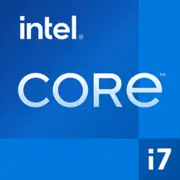Intel Core i7-6700T

Intel Core i7-6700T: Review and Relevance in 2025
Energy efficiency and stability for niche tasks
Key Features: Skylake Architecture and Performance Balance
The Intel Core i7-6700T processor, released in 2015, remains in demand in 2025 thanks to its unique niche—low power consumption (TDP of 35W) while maintaining respectable performance.
Architecture and Manufacturing Process:
- Skylake (14 nm): An optimized architecture with improved IPC (instructions per cycle) compared to previous generations.
- 4 cores / 8 threads: Hyper-Threading support allows for effective multitasking.
- Base frequency 2.8 GHz / Turbo Boost up to 3.6 GHz: Dynamic frequency scaling for peak loads.
- Integrated Graphics HD Graphics 530: 24 execution units, supporting 4K@60Hz via DisplayPort.
Performance:
- Geekbench 6: 1185 (single-core) / 3613 (multi-core) — sufficient for office tasks and light content creation.
- L3 Cache (8 MB): Reduces data access latency.
Key Features:
- Speed Shift Technology: Quick frequency switching for energy savings.
- VT-x and VT-d Support: Virtualization for server tasks.
Compatible Motherboards: LGA 1151 Socket and Chipset Choices
The processor uses the LGA 1151 (version v1) socket, limiting motherboard choices to models from 2015–2017:
- Chipsets: H110, B150, H170, Z170.
- Recommendations:
- For Basic Systems: H110 (cheap, but lacks USB 3.1 Gen2 and has a limited number of PCIe lanes).
- For Balance: B150 or H170 (supports DDR4, more SATA/USB ports).
- Z170: Overkill, since the i7-6700T has a locked multiplier (overclocking is not possible).
Practical Example: The ASUS H170-PRO motherboard (around $90–120 on the second-hand market) provides stable operation with dual-channel DDR4 and an M.2 slot (PCIe 3.0 x4).
Supported Memory: DDR4 vs DDR3L
The processor is compatible with:
- DDR4-2133 MHz (recommended): The optimal choice for speed and stability.
- DDR3L-1600 MHz: Support exists, but such motherboards are rare.
Tips:
- Use dual-channel mode (2×8 GB DDR4) to improve performance in gaming and rendering.
- Avoid DDR3L—a deprecated standard with lower energy efficiency.
Power Supplies: Minimum Power, Maximum Reliability
With a TDP of 35W, the processor is highly undemanding when it comes to PSUs:
- Minimum Power: 300–400W (considering an entry-level graphics card, e.g., GTX 1650).
- Recommendations:
- Without Discrete Graphics: A 250W PSU (e.g., Seasonic SSP-250ES) — quiet and reliable.
- With GPU: EVGA 500 W1 (80+ White, $45) or Corsair CX450 (80+ Bronze, $60).
Important: Don’t skimp on the PSU—poor-quality models can damage components.
Pros and Cons: Who is the i7-6700T Relevant for in 2025?
Pros:
- Low power consumption—ideal for HTPCs (home theaters) and office PCs.
- Sufficient performance for everyday tasks (browsing, office applications).
- Integrated graphics with 4K support.
Cons:
- No support for PCIe 4.0/5.0 or DDR5—limitations for modern gaming and SSDs.
- Outdated manufacturing process (14 nm vs. 7 nm in Ryzen 5000/7000).
- Price: New units (if available) cost $150–200, which is unjustifiable for an old architecture.
Use Scenarios: From Office to Media Center
1. Office Tasks: Document work, video conferencing, multitasking (Chrome + Excel).
2. Media Center: Streaming 4K video, streaming via Plex.
3. Light Gaming: CS:GO, Dota 2 at low settings (HD 530 delivers ~30–40 FPS at Full HD).
4. Server Tasks: NAS or home server due to low TDP.
Real Example: A build with i7-6700T + 16 GB DDR4 + 512 GB SSD consumes ~50W under load, which is cheaper to operate than modern systems.
Comparison with Competitors: AMD vs Intel
- AMD Ryzen 5 1600 (6 cores/12 threads): More powerful in multi-threaded tasks (Geekbench 6 Multi ~4500), but TDP of 65W and requires a separate graphics card.
- Intel Core i5-7600K: Higher frequency (3.8 GHz), but only 4 threads and TDP of 91W.
Conclusion: The i7-6700T excels in energy efficiency but falls short in absolute performance.
Assembly Tips: Budget Optimization
1. Motherboard: Look for models with M.2 and USB 3.1 (ASUS B150M-A).
2. Memory: 16 GB DDR4-2133 is optimal.
3. Storage: An SSD (Kingston A2000 1 TB, $70) is essential for a responsive system.
4. Cooling: The stock cooler is sufficient—the processor runs cool.
Conclusion: Who Will Benefit from the i7-6700T in 2025?
This processor should only be considered in specific scenarios:
- Budget Office PCs: Where low ownership costs are important.
- Home Media Centers: A quiet and economical system for TV.
- Servers/NAS: Low power consumption 24/7.
However, it is already outdated for gaming, video editing, or AI work. If the budget allows, it’s better to choose the Ryzen 5 5500 (6 cores, $120) or Intel Core i3-12100 (4 cores, Alder Lake, $110).
Price: New i7-6700Ts (rare leftovers) are $150–200, but it’s more cost-effective to buy used for $50–80.
In 2025, the Intel Core i7-6700T is a choice for those who value reliability and minimalism over raw performance.
Basic
CPU Specifications
Memory Specifications
GPU Specifications
Miscellaneous
Benchmarks
Compared to Other CPU
Share in social media
Or Link To Us
<a href="https://cputronic.com/cpu/intel-core-i7-6700t" target="_blank">Intel Core i7-6700T</a>